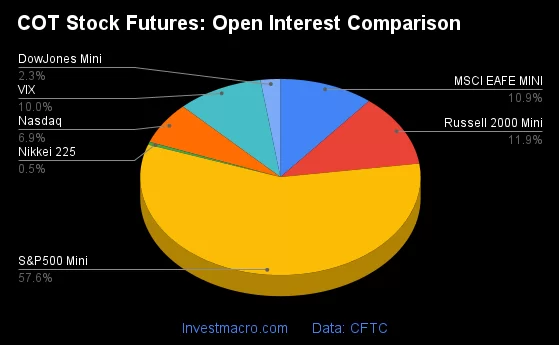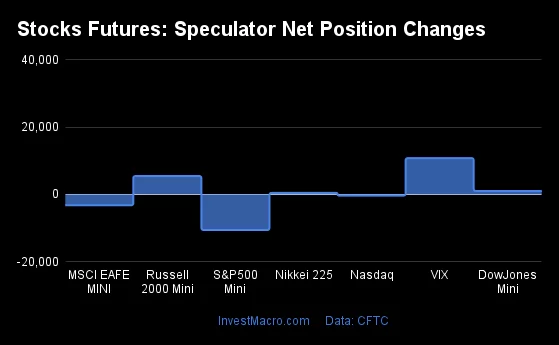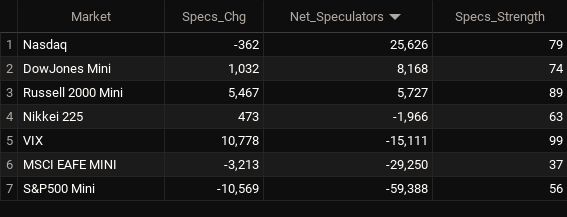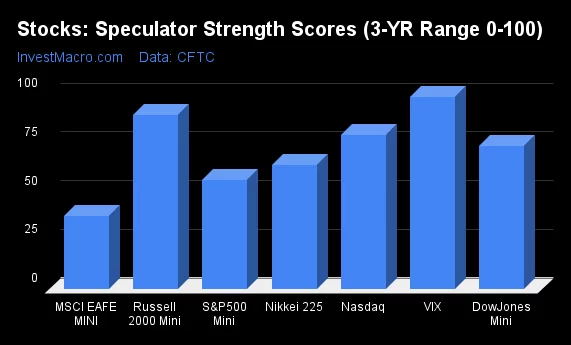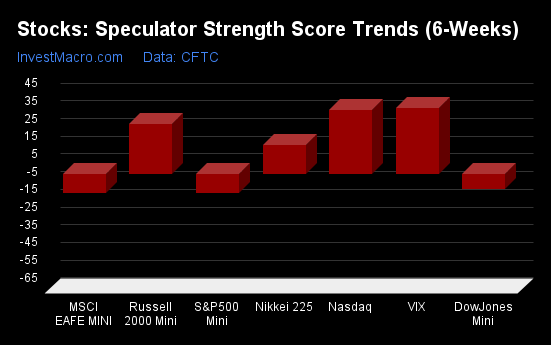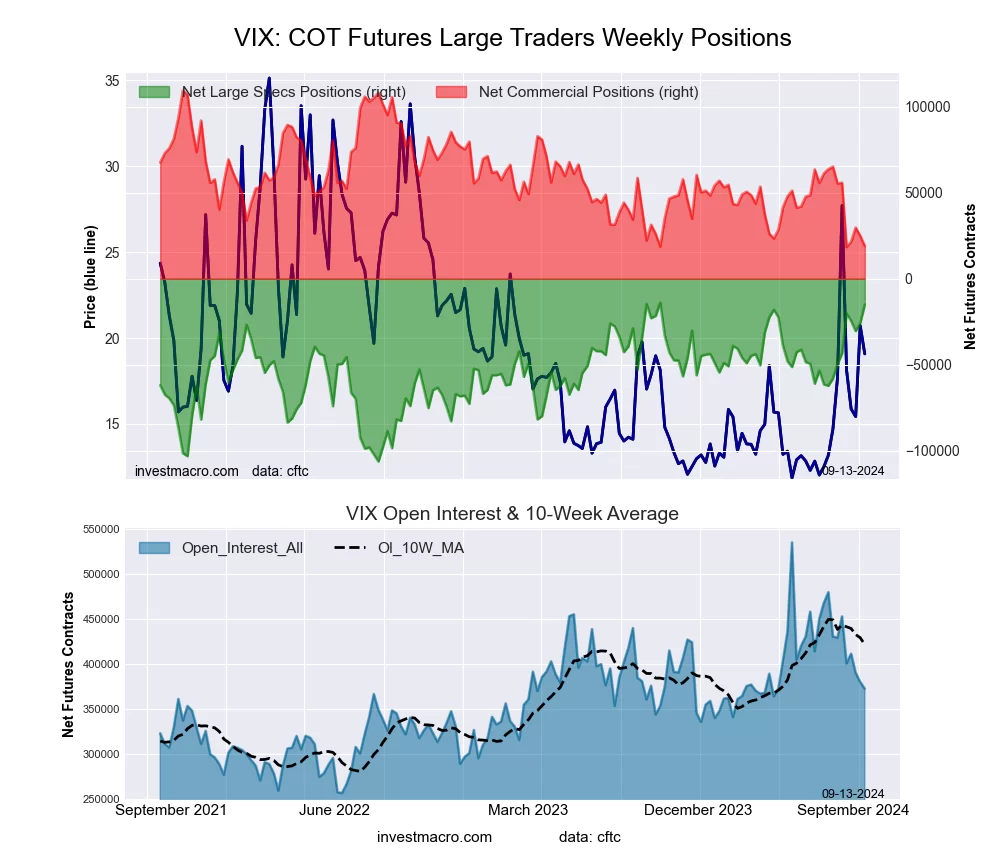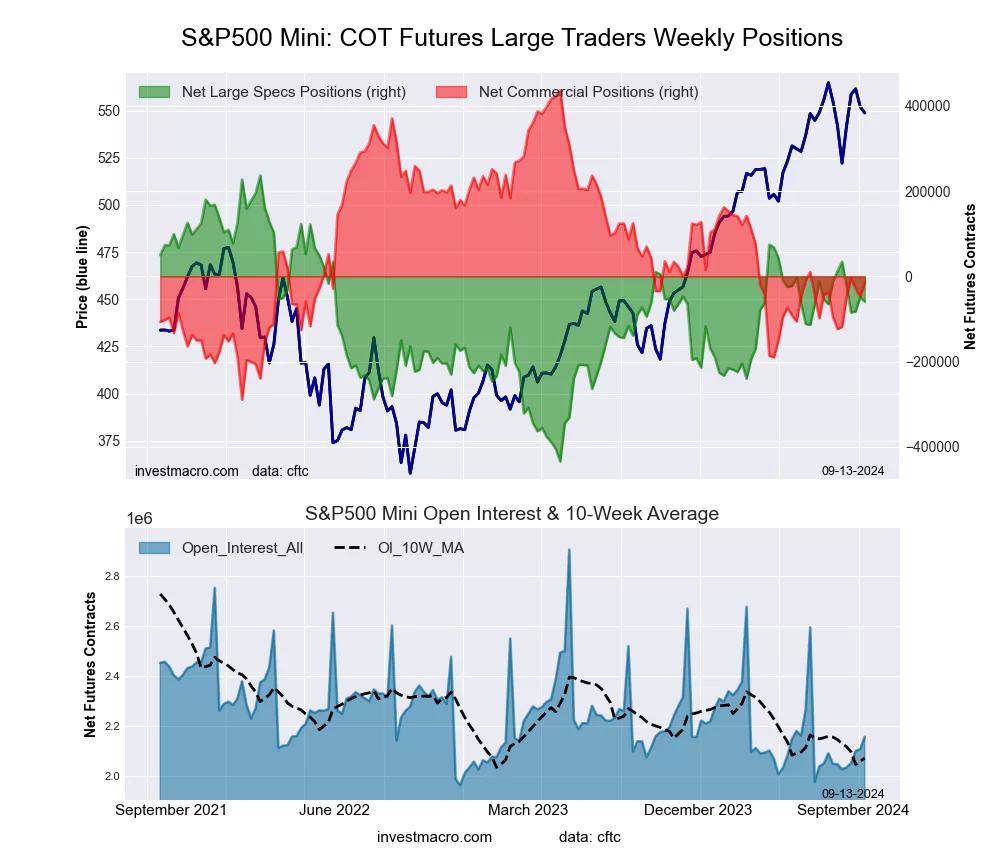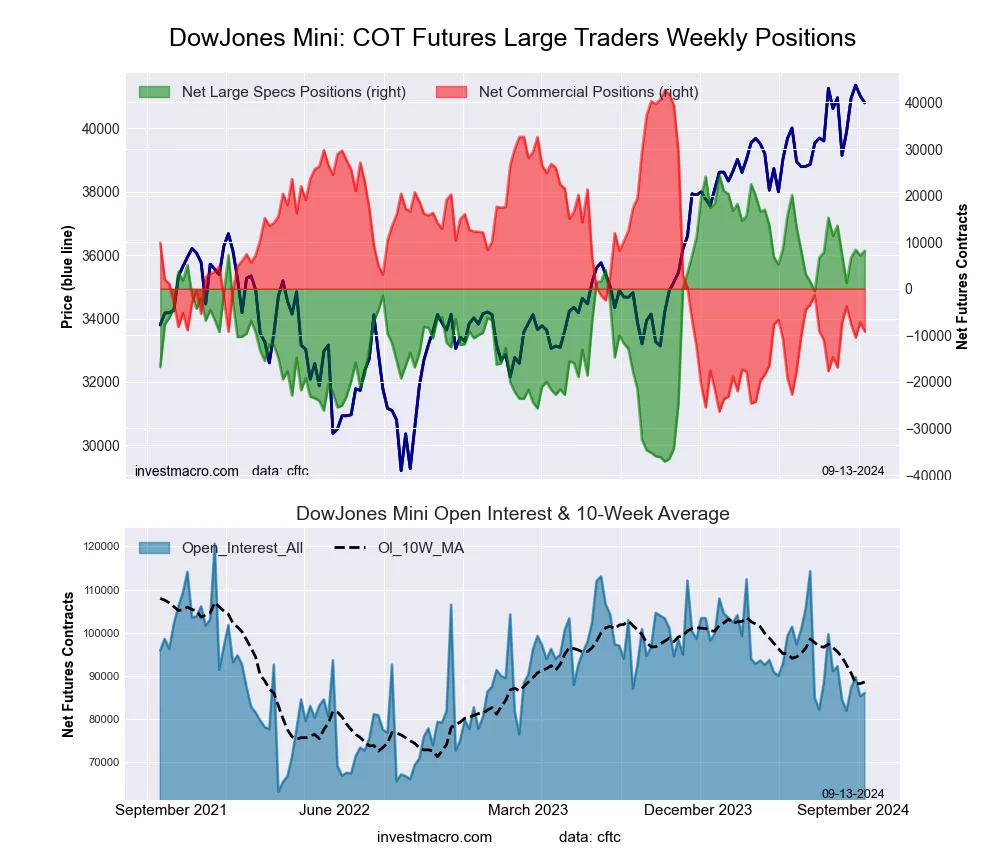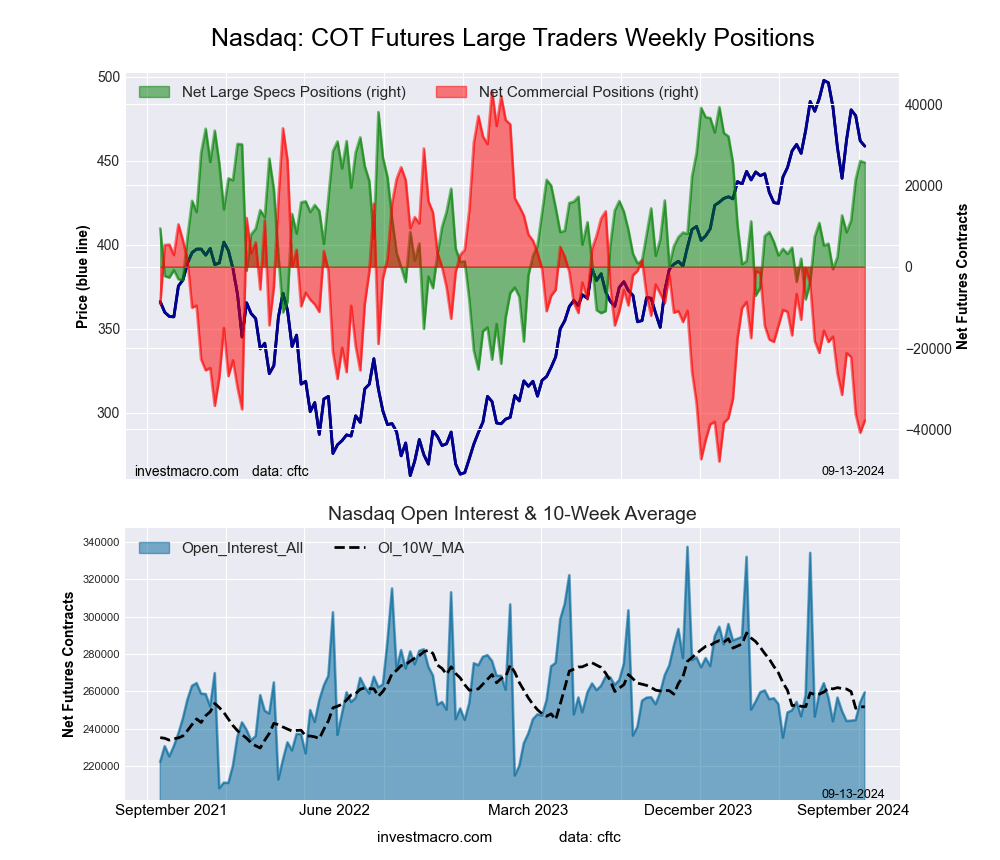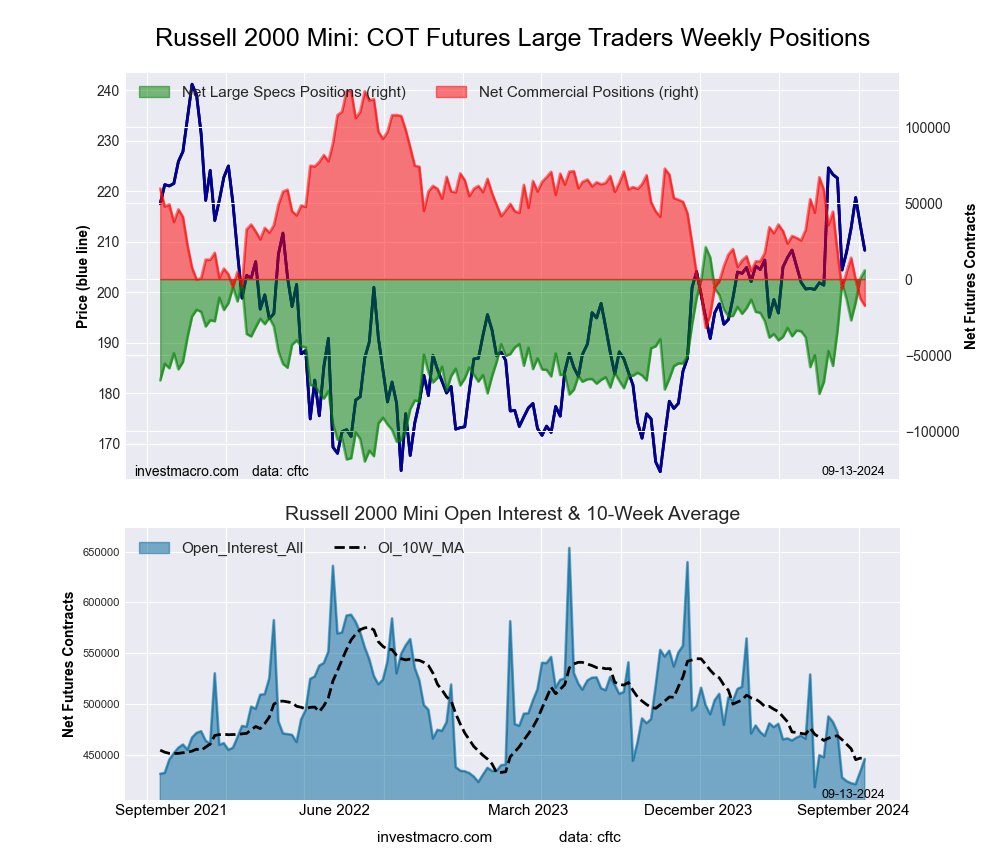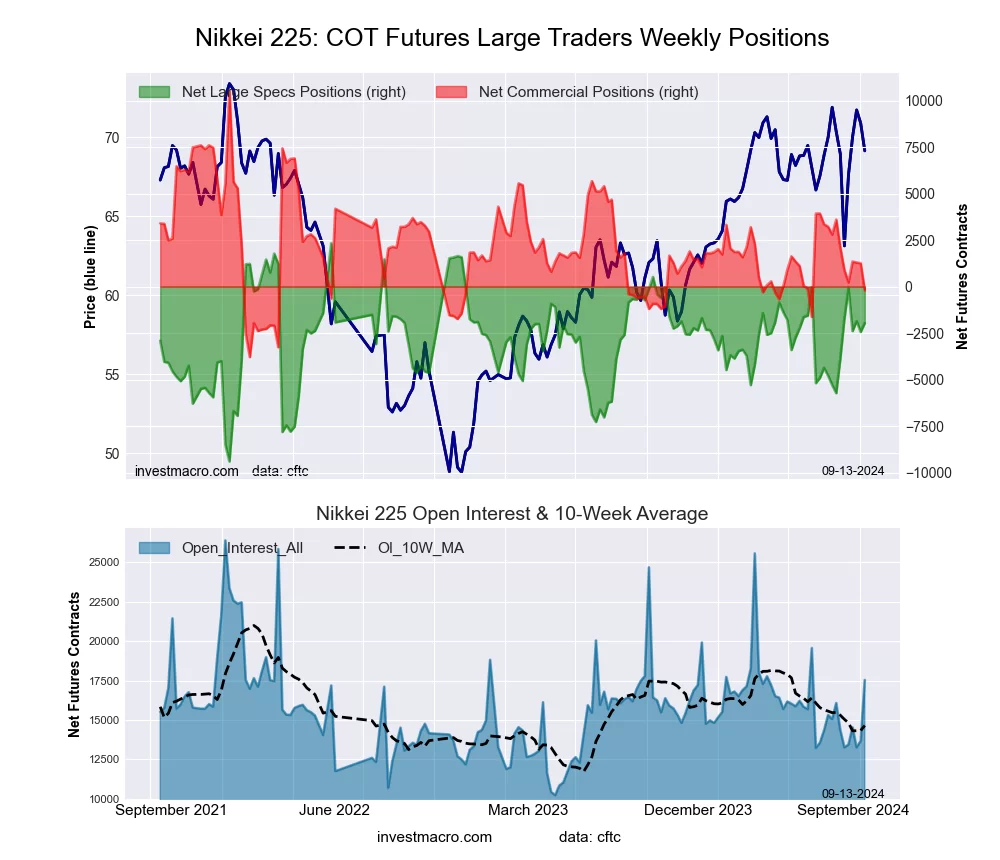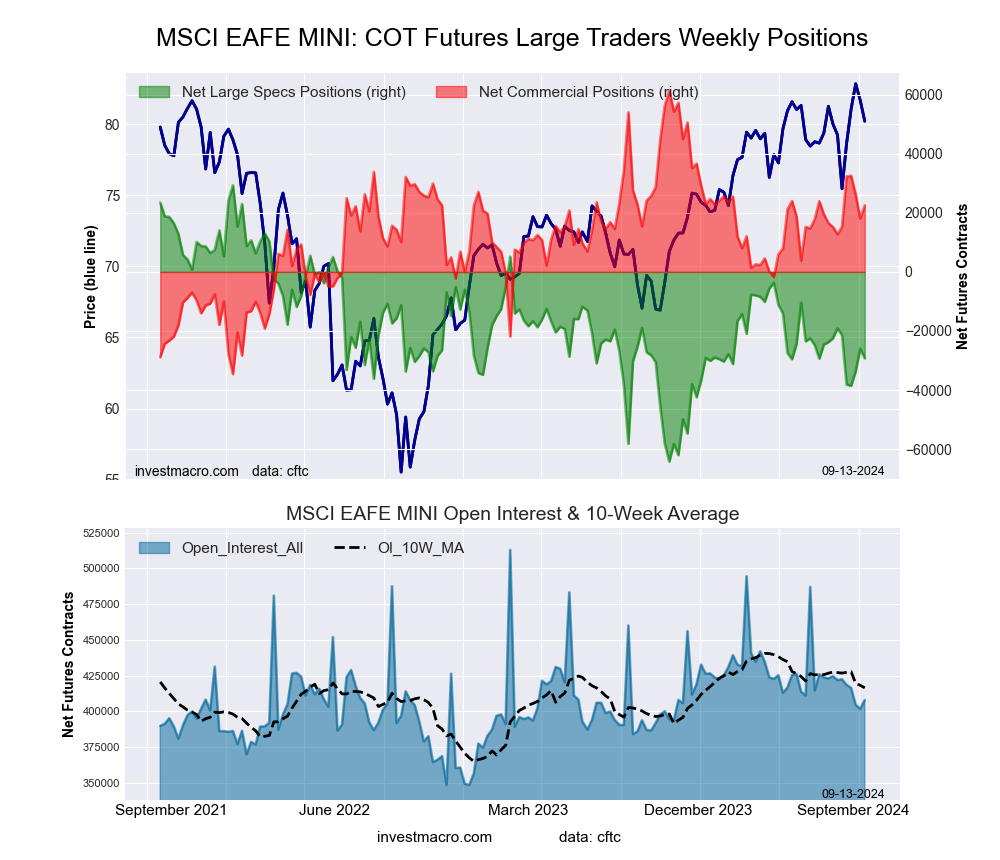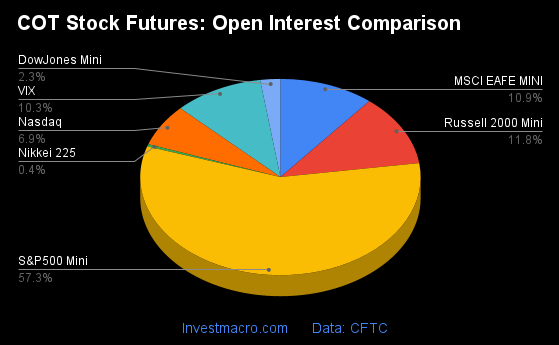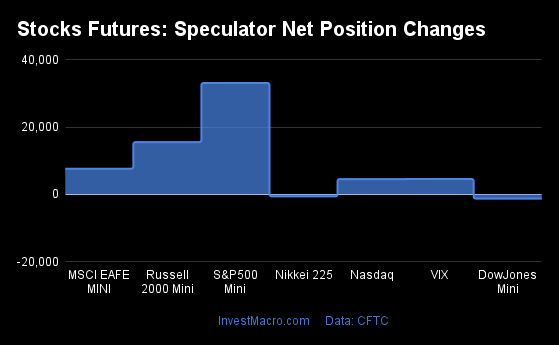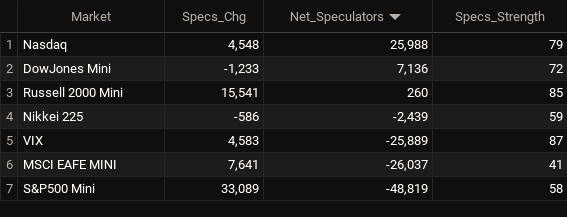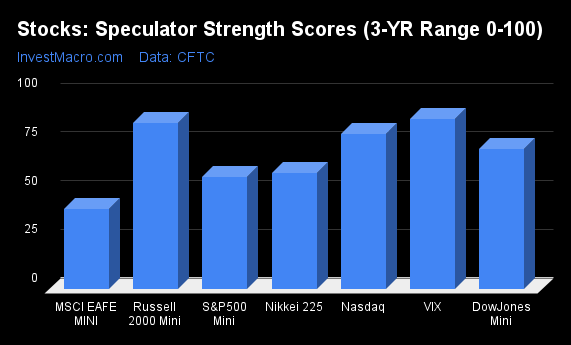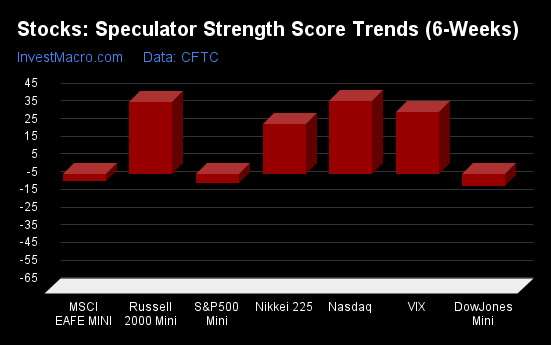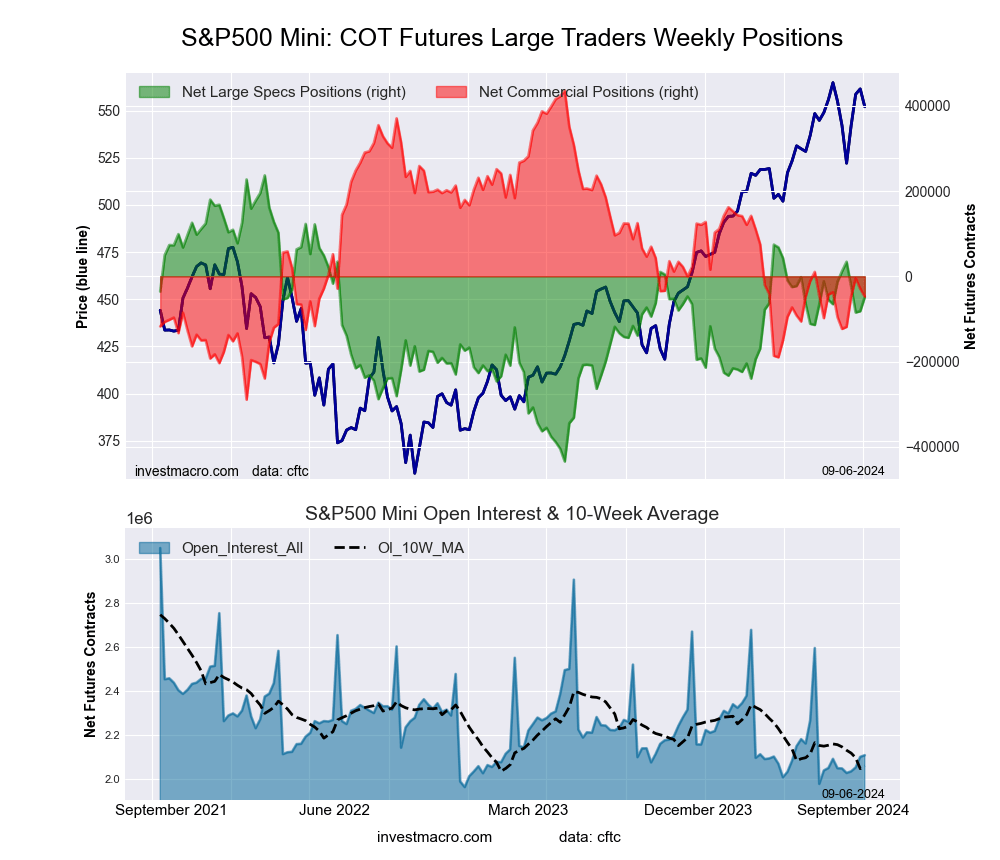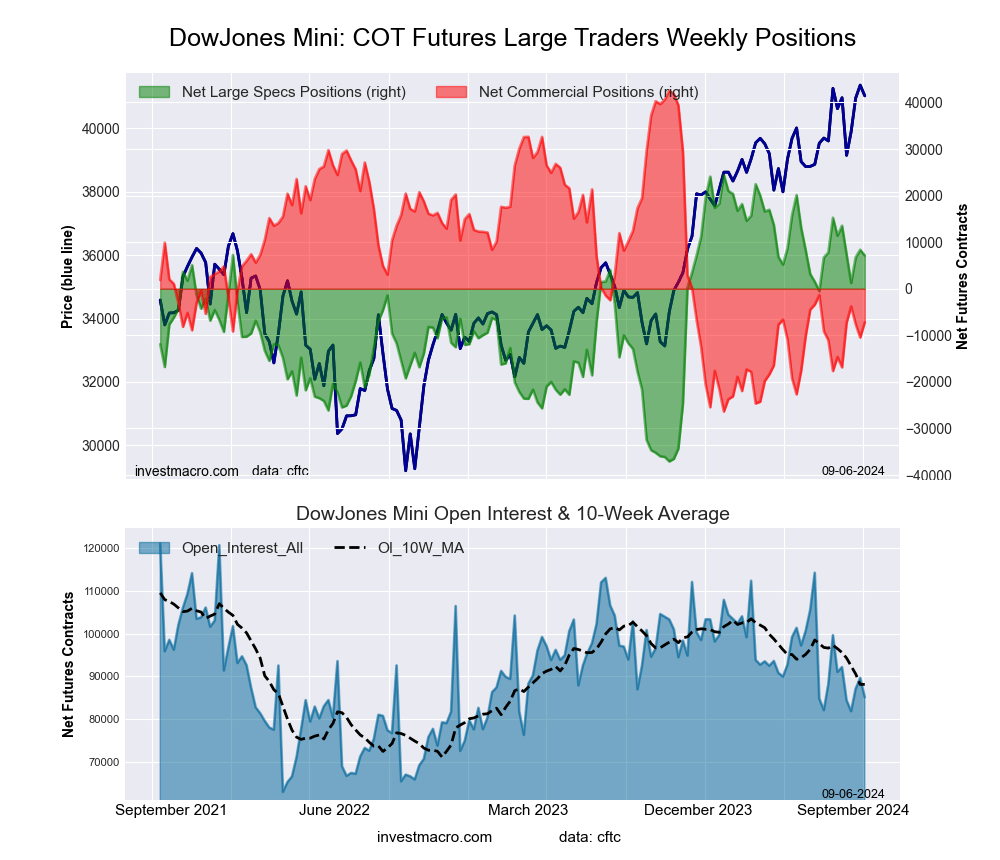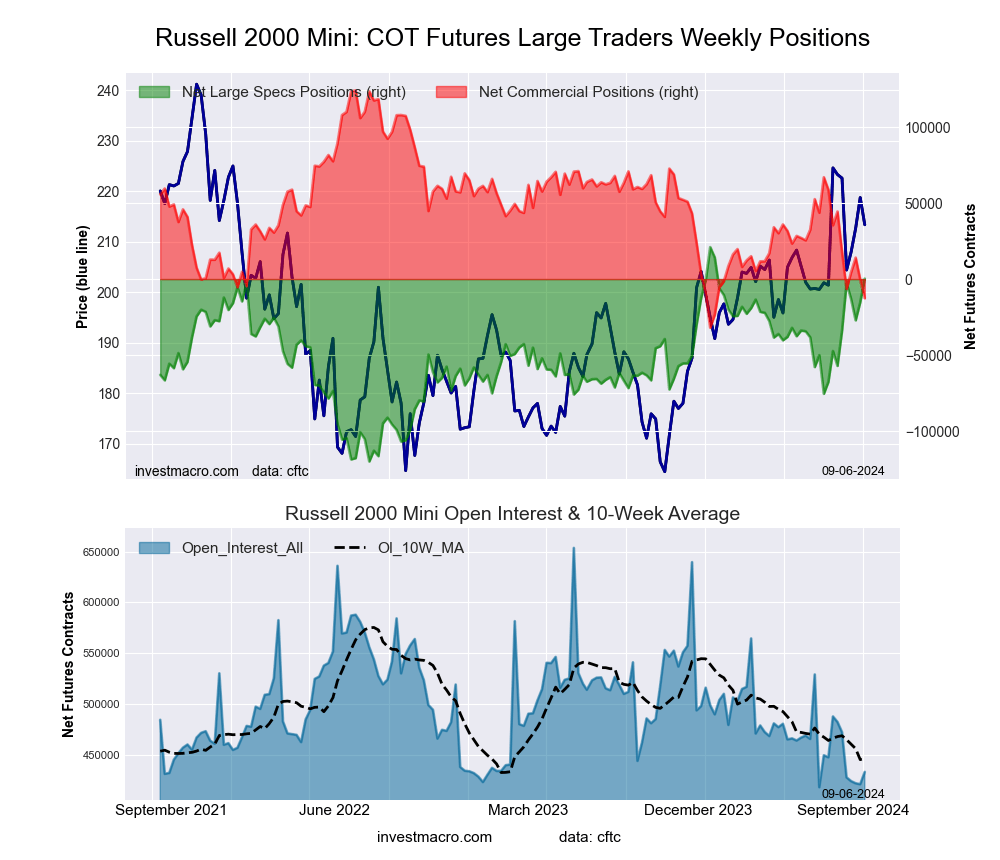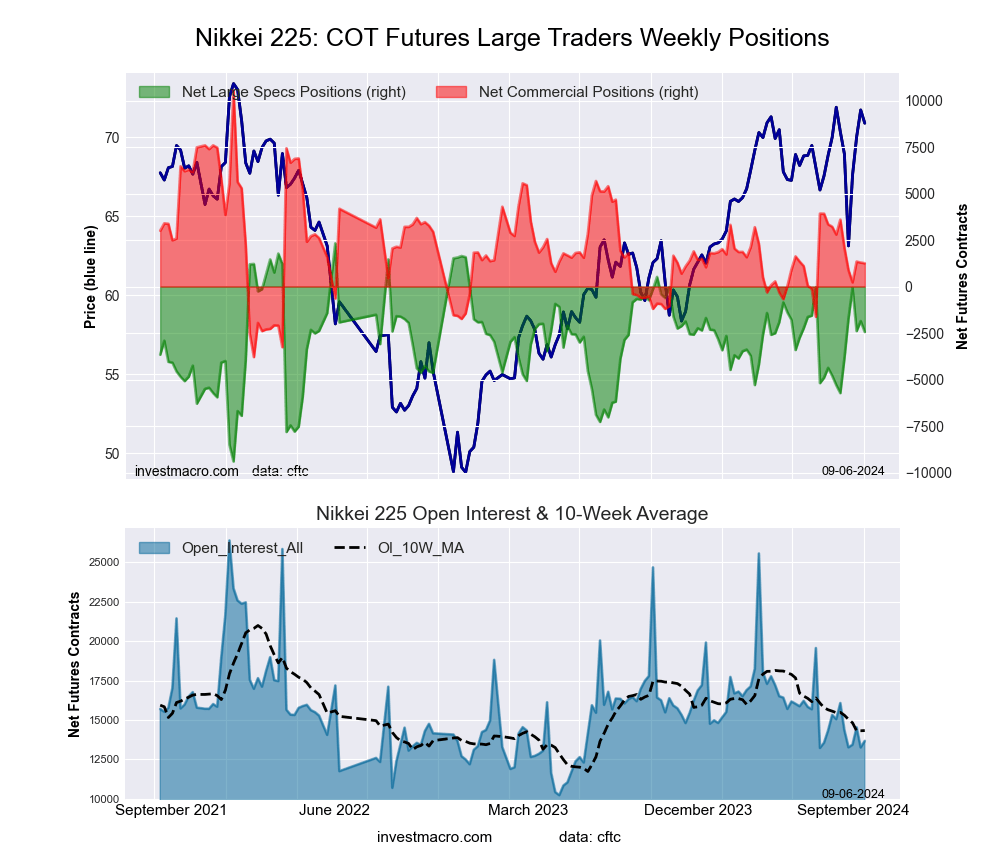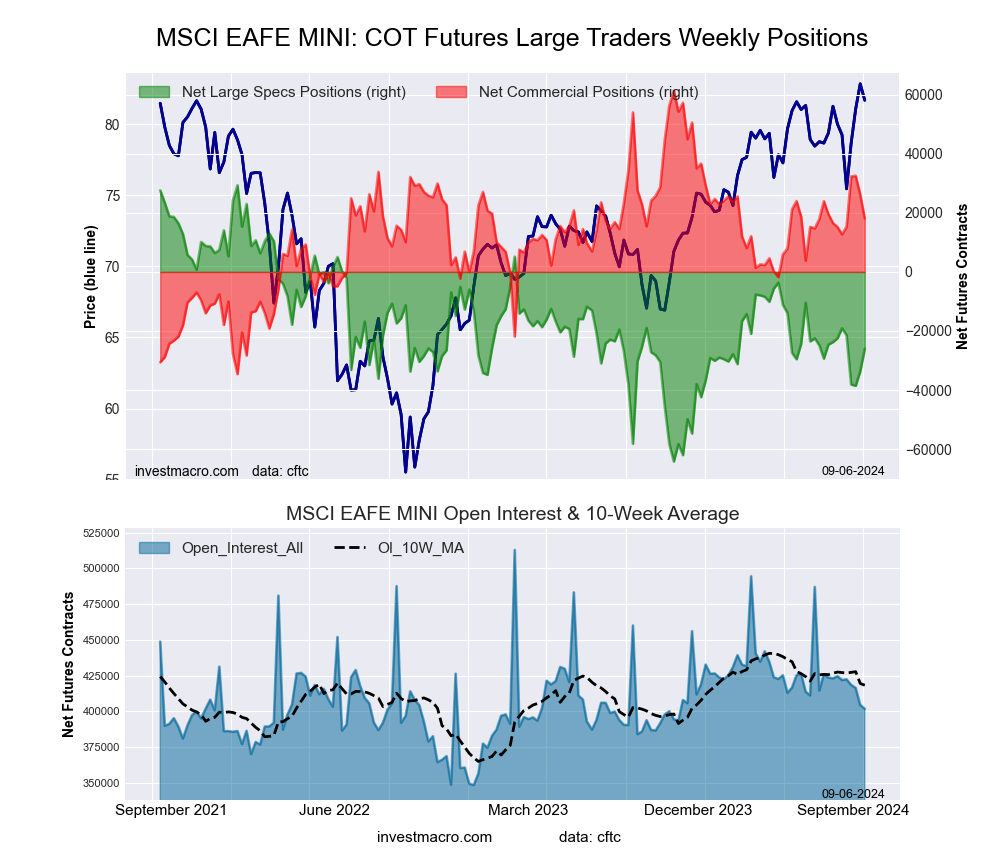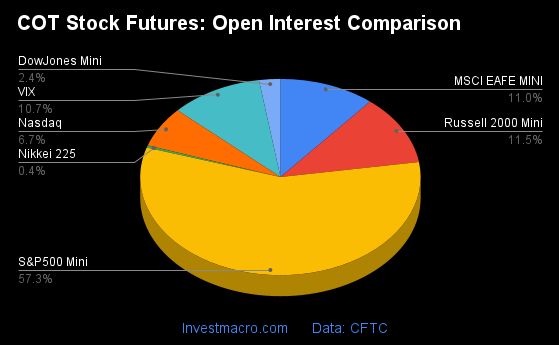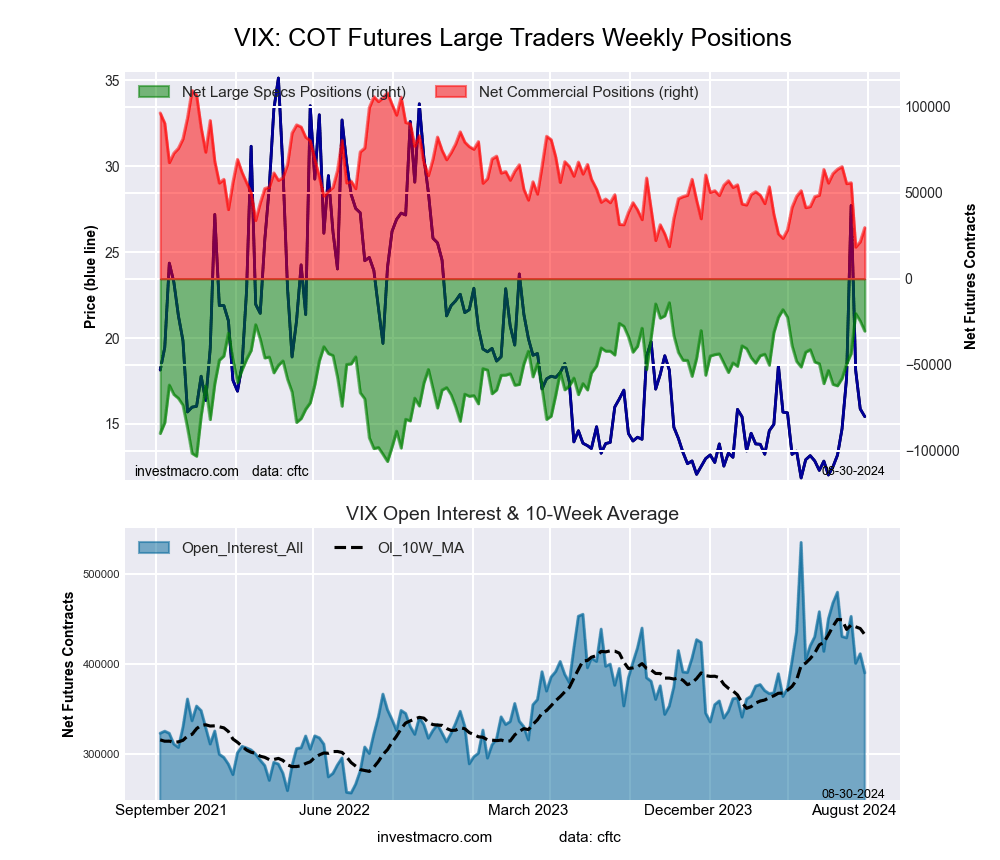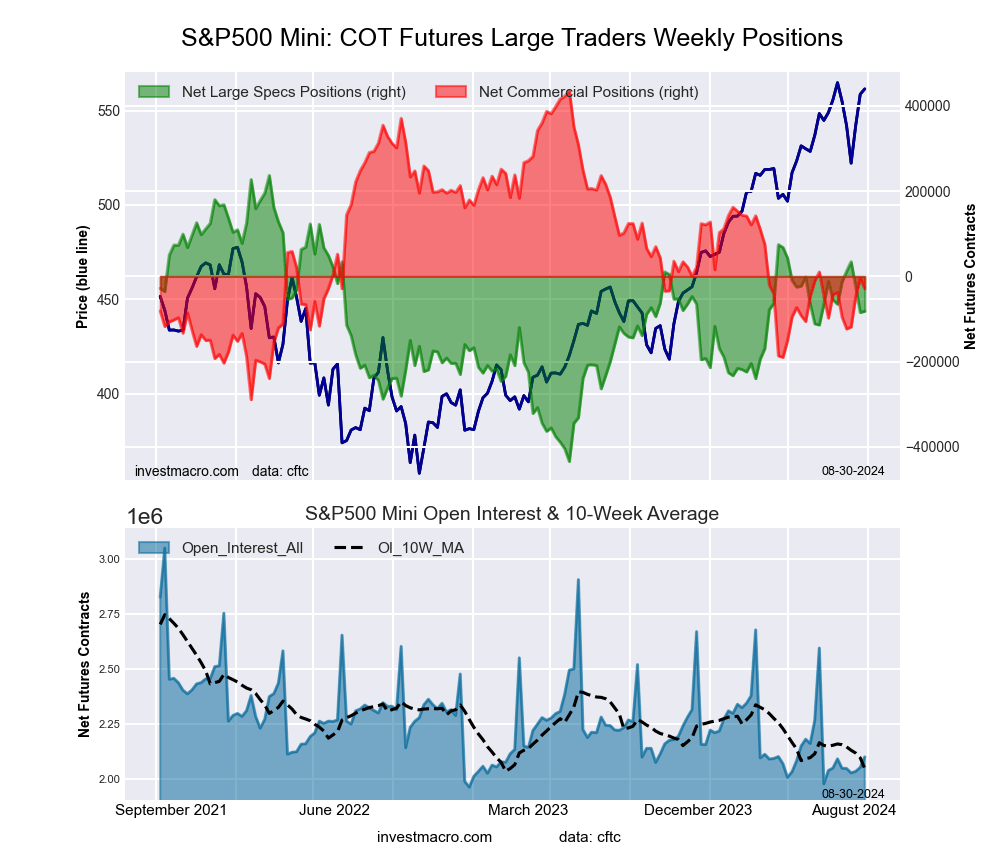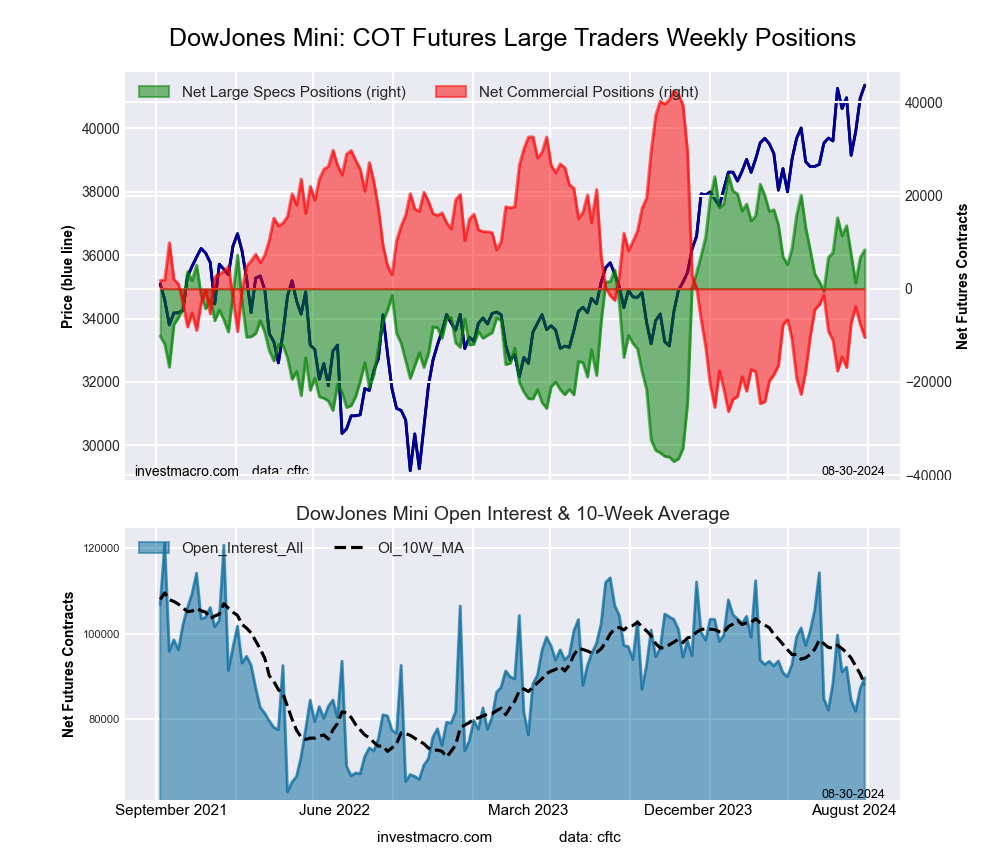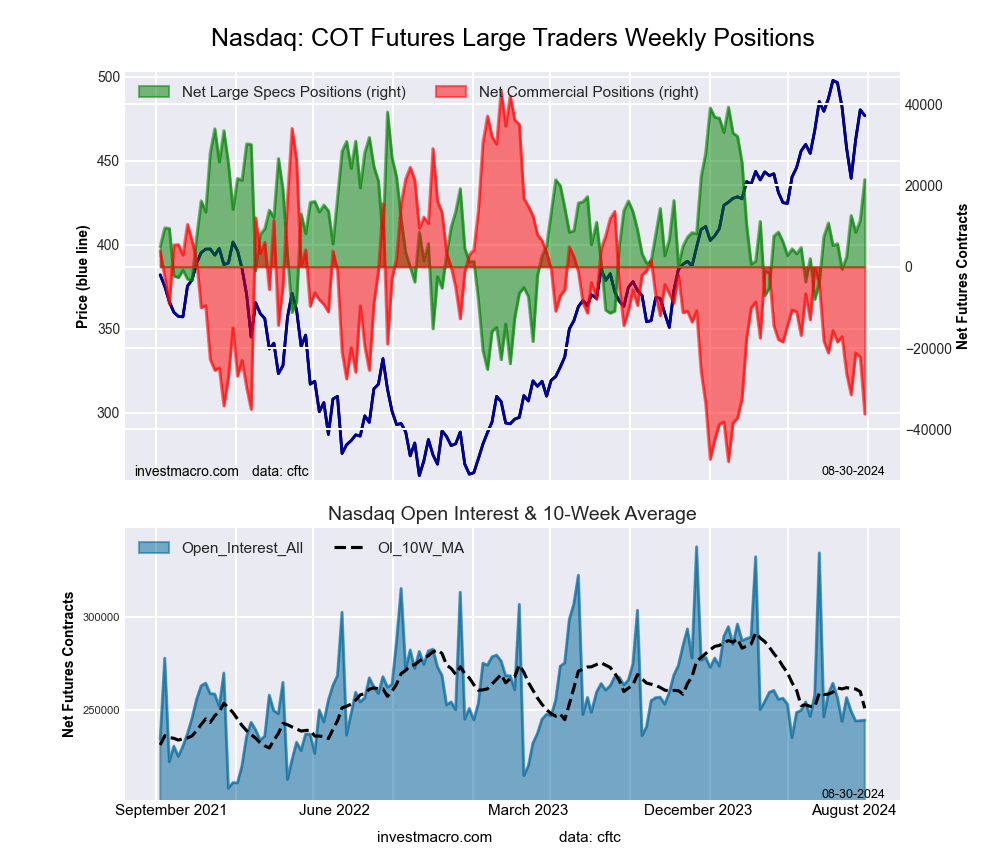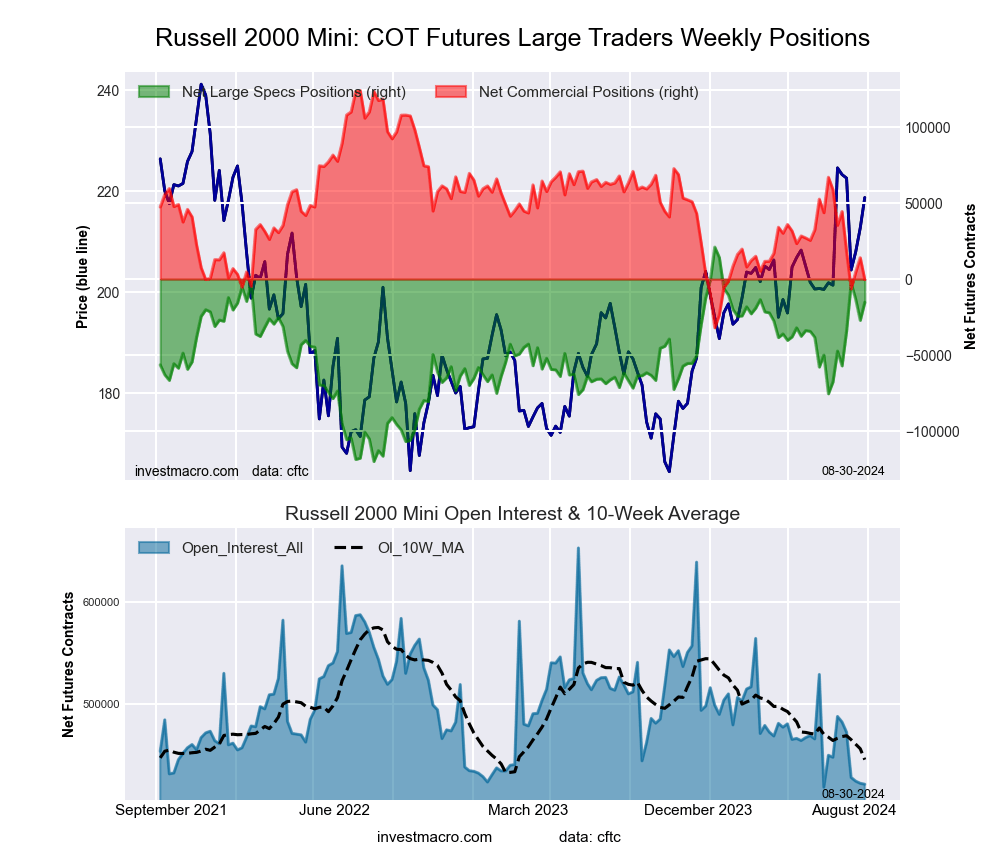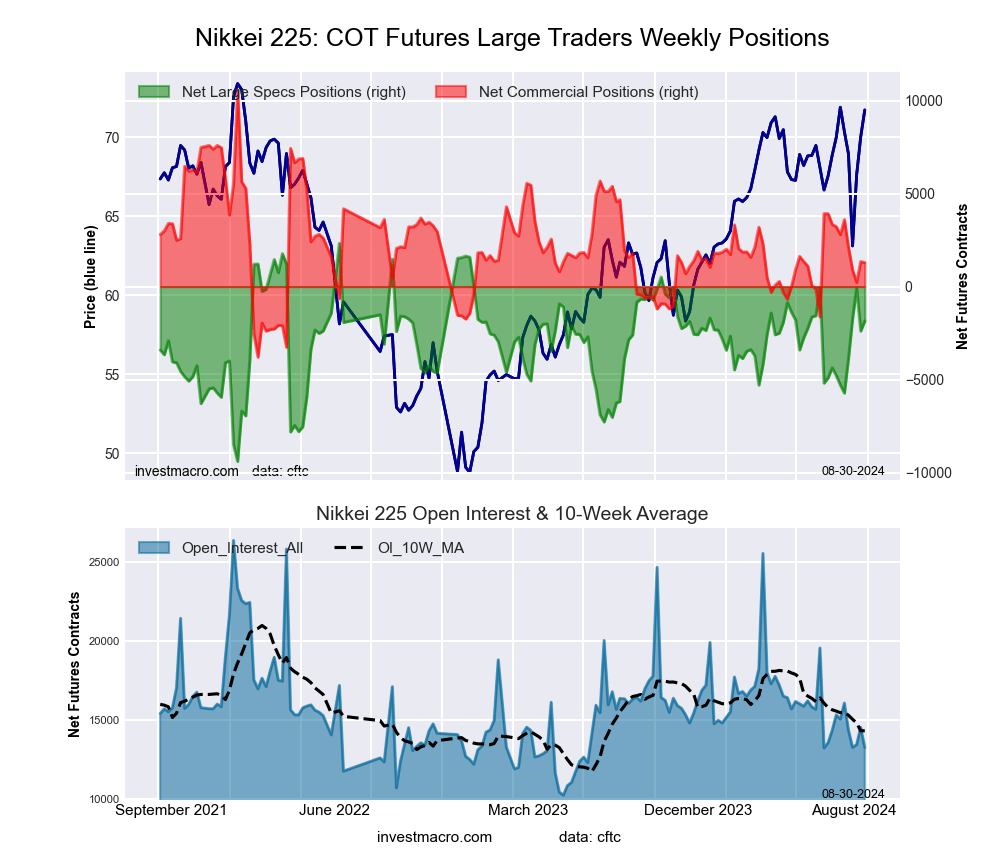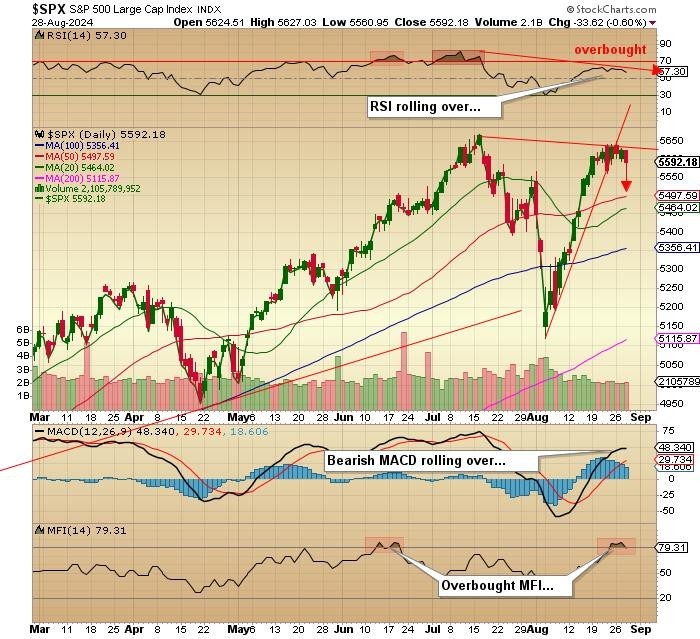By InvestMacro
Here are the latest charts and statistics for the Commitment of Traders (COT) data published by the Commodities Futures Trading Commission (CFTC).
The latest COT data is updated through Tuesday September 24th and shows a quick view of how large traders (for-profit speculators and commercial entities) were positioned in the futures markets.
Weekly Speculator Changes led by S&P500-Mini & Russell-Mini
The COT stock markets speculator bets were higher this week as five out of the seven stock markets we cover had higher positioning while the other two markets had lower speculator contracts.
Leading the gains for the stock markets was the S&P500-Mini (87,195 contracts) with the Russell-Mini (18,921 contracts), the MSCI EAFE-Mini (5,043 contracts), the VIX (1,446 contracts) and the DowJones-Mini (822 contracts) also showing positive weeks.
The markets with declines in speculator bets were the Nasdaq-Mini (-3,194 contracts) and the Nikkei 225 (-498 contracts) for the week.
Stock Market Net Speculators Leaderboard
Legend: Weekly Speculators Change | Speculators Current Net Position | Speculators Strength Score compared to last 3-Years (0-100 range)
Strength Scores led by VIX & Russell-Mini
COT Strength Scores (a normalized measure of Speculator positions over a 3-Year range, from 0 to 100 where above 80 is Extreme-Bullish and below 20 is Extreme-Bearish) showed that the VIX (100 percent) and the Russell-Mini (100 percent) lead the stock markets this week. The DowJones-Mini (85 percent) and the Nasdaq-Mini (64 percent) come in as the next highest in the weekly strength scores.
On the downside, the MSCI EAFE-Mini (30 percent) comes in at the lowest strength level currently.
Strength Statistics:
VIX (100.0 percent) vs VIX previous week (98.6 percent)
S&P500-Mini (59.4 percent) vs S&P500-Mini previous week (46.4 percent)
DowJones-Mini (85.4 percent) vs DowJones-Mini previous week (84.1 percent)
Nasdaq-Mini (64.0 percent) vs Nasdaq-Mini previous week (69.0 percent)
Russell2000-Mini (100.0 percent) vs Russell2000-Mini previous week (86.7 percent)
Nikkei USD (59.2 percent) vs Nikkei USD previous week (63.4 percent)
EAFE-Mini (30.5 percent) vs EAFE-Mini previous week (25.1 percent)
Russell-Mini & DowJones-Mini top the 6-Week Strength Trends
COT Strength Score Trends (or move index, calculates the 6-week changes in strength scores) showed that the Russell-Mini (25 percent) leads the past six weeks trends for the stock markets. The DowJones-Mini (23 percent), the VIX (15 percent) and the Nasdaq-Mini (12 percent) are the next highest positive movers in the latest trends data.
The Nikkei 225 (-6 percent) leads the downside trend scores currently with the S&P500-Mini (-2 percent) coming in as the next market with lower trend scores.
Strength Trend Statistics:
VIX (15.0 percent) vs VIX previous week (36.6 percent)
S&P500-Mini (-1.8 percent) vs S&P500-Mini previous week (-23.4 percent)
DowJones-Mini (23.1 percent) vs DowJones-Mini previous week (11.8 percent)
Nasdaq-Mini (11.7 percent) vs Nasdaq-Mini previous week (10.3 percent)
Russell2000-Mini (24.8 percent) vs Russell2000-Mini previous week (3.9 percent)
Nikkei USD (-6.3 percent) vs Nikkei USD previous week (16.2 percent)
EAFE-Mini (2.6 percent) vs EAFE-Mini previous week (-20.6 percent)
Individual Stock Market Charts:
VIX Volatility Futures:
 The VIX Volatility large speculator standing this week recorded a net position of -5,067 contracts in the data reported through Tuesday. This was a weekly boost of 1,446 contracts from the previous week which had a total of -6,513 net contracts.
The VIX Volatility large speculator standing this week recorded a net position of -5,067 contracts in the data reported through Tuesday. This was a weekly boost of 1,446 contracts from the previous week which had a total of -6,513 net contracts.
This week’s current strength score (the trader positioning range over the past three years, measured from 0 to 100) shows the speculators are currently Bullish-Extreme with a score of 100.0 percent. The commercials are Bearish-Extreme with a score of 0.0 percent and the small traders (not shown in chart) are Bullish with a score of 78.8 percent.
Price Trend-Following Model: Uptrend
Our weekly trend-following model classifies the current market price position as: Uptrend.
| VIX Volatility Futures Statistics | SPECULATORS | COMMERCIALS | SMALL TRADERS |
| – Percent of Open Interest Longs: | 24.1 | 40.9 | 8.8 |
| – Percent of Open Interest Shorts: | 25.7 | 38.8 | 9.3 |
| – Net Position: | -5,067 | 6,667 | -1,600 |
| – Gross Longs: | 76,551 | 129,988 | 27,965 |
| – Gross Shorts: | 81,618 | 123,321 | 29,565 |
| – Long to Short Ratio: | 0.9 to 1 | 1.1 to 1 | 0.9 to 1 |
| NET POSITION TREND: | |||
| – Strength Index Score (3 Year Range Pct): | 100.0 | 0.0 | 78.8 |
| – Strength Index Reading (3 Year Range): | Bullish-Extreme | Bearish-Extreme | Bullish |
| NET POSITION MOVEMENT INDEX: | |||
| – 6-Week Change in Strength Index: | 15.0 | -11.4 | -15.7 |
S&P500 Mini Futures:
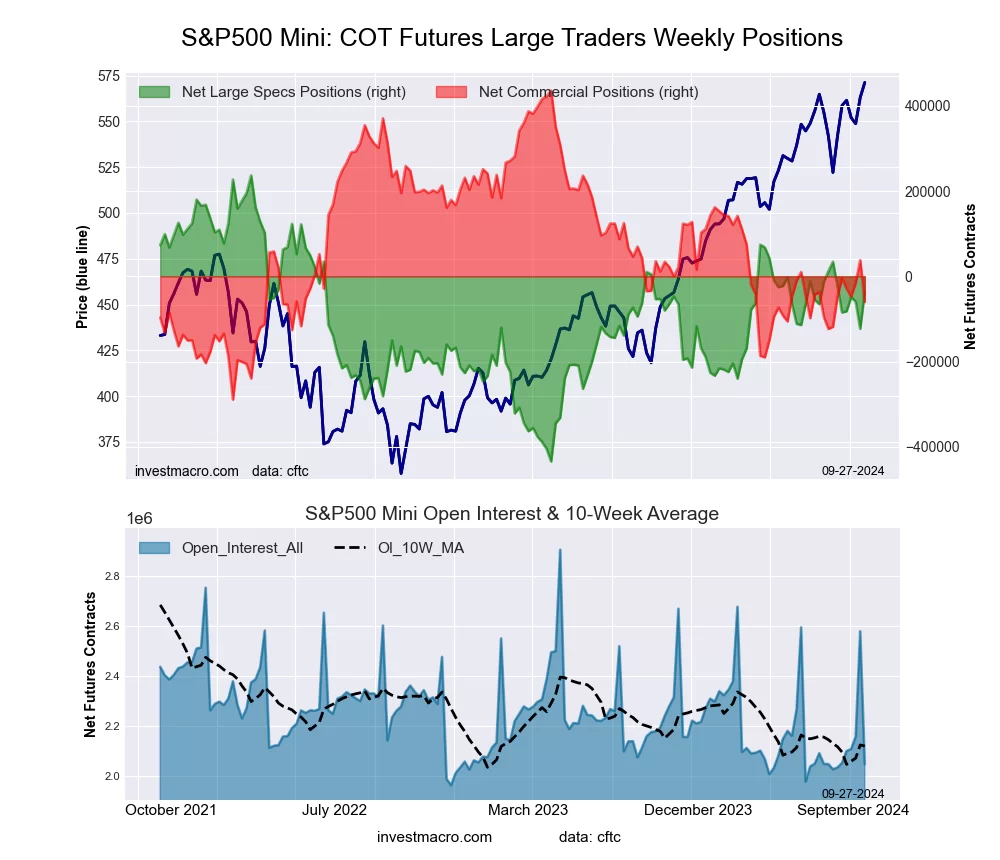 The S&P500 Mini large speculator standing this week recorded a net position of -35,753 contracts in the data reported through Tuesday. This was a weekly lift of 87,195 contracts from the previous week which had a total of -122,948 net contracts.
The S&P500 Mini large speculator standing this week recorded a net position of -35,753 contracts in the data reported through Tuesday. This was a weekly lift of 87,195 contracts from the previous week which had a total of -122,948 net contracts.
This week’s current strength score (the trader positioning range over the past three years, measured from 0 to 100) shows the speculators are currently Bullish with a score of 59.4 percent. The commercials are Bearish with a score of 31.6 percent and the small traders (not shown in chart) are Bullish-Extreme with a score of 87.6 percent.
Price Trend-Following Model: Strong Uptrend
Our weekly trend-following model classifies the current market price position as: Strong Uptrend.
| S&P500 Mini Futures Statistics | SPECULATORS | COMMERCIALS | SMALL TRADERS |
| – Percent of Open Interest Longs: | 14.2 | 71.6 | 12.5 |
| – Percent of Open Interest Shorts: | 15.9 | 74.5 | 7.9 |
| – Net Position: | -35,753 | -59,919 | 95,672 |
| – Gross Longs: | 289,938 | 1,464,276 | 256,340 |
| – Gross Shorts: | 325,691 | 1,524,195 | 160,668 |
| – Long to Short Ratio: | 0.9 to 1 | 1.0 to 1 | 1.6 to 1 |
| NET POSITION TREND: | |||
| – Strength Index Score (3 Year Range Pct): | 59.4 | 31.6 | 87.6 |
| – Strength Index Reading (3 Year Range): | Bullish | Bearish | Bullish-Extreme |
| NET POSITION MOVEMENT INDEX: | |||
| – 6-Week Change in Strength Index: | -1.8 | -1.7 | 11.4 |
Dow Jones Mini Futures:
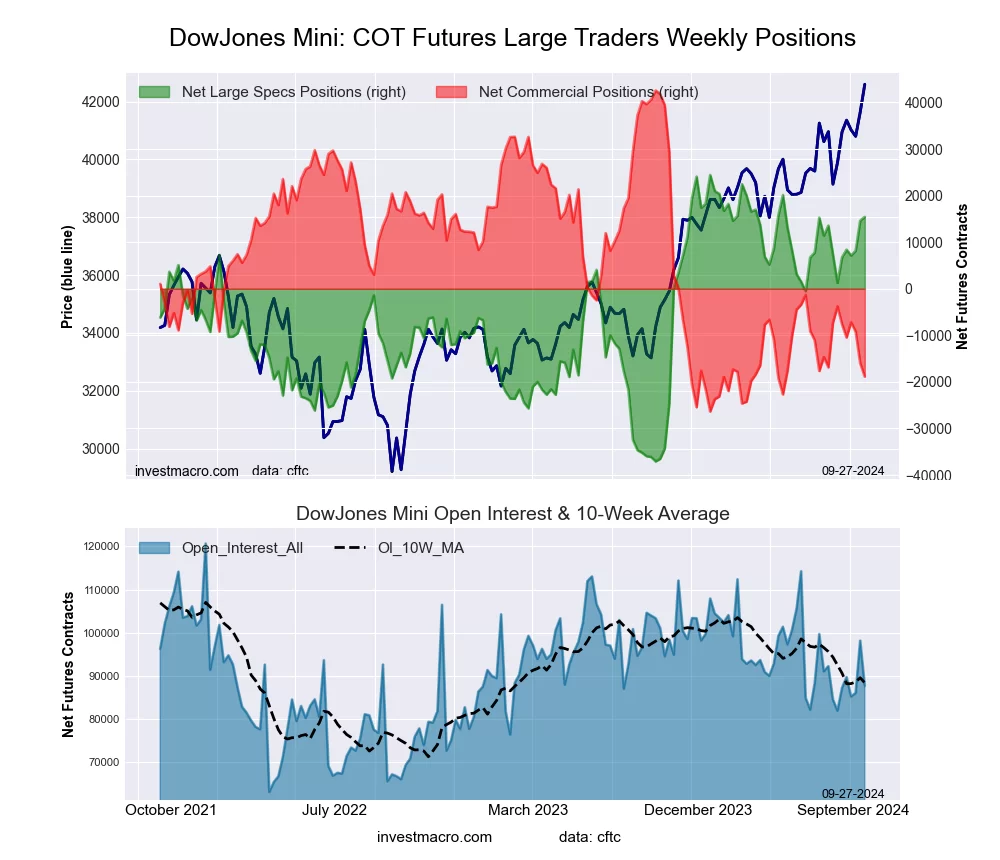 The Dow Jones Mini large speculator standing this week recorded a net position of 15,436 contracts in the data reported through Tuesday. This was a weekly increase of 822 contracts from the previous week which had a total of 14,614 net contracts.
The Dow Jones Mini large speculator standing this week recorded a net position of 15,436 contracts in the data reported through Tuesday. This was a weekly increase of 822 contracts from the previous week which had a total of 14,614 net contracts.
This week’s current strength score (the trader positioning range over the past three years, measured from 0 to 100) shows the speculators are currently Bullish-Extreme with a score of 85.4 percent. The commercials are Bearish-Extreme with a score of 10.9 percent and the small traders (not shown in chart) are Bullish with a score of 75.2 percent.
Price Trend-Following Model: Strong Uptrend
Our weekly trend-following model classifies the current market price position as: Strong Uptrend.
| Dow Jones Mini Futures Statistics | SPECULATORS | COMMERCIALS | SMALL TRADERS |
| – Percent of Open Interest Longs: | 26.5 | 55.0 | 17.0 |
| – Percent of Open Interest Shorts: | 8.9 | 76.5 | 13.1 |
| – Net Position: | 15,436 | -18,853 | 3,417 |
| – Gross Longs: | 23,223 | 48,223 | 14,893 |
| – Gross Shorts: | 7,787 | 67,076 | 11,476 |
| – Long to Short Ratio: | 3.0 to 1 | 0.7 to 1 | 1.3 to 1 |
| NET POSITION TREND: | |||
| – Strength Index Score (3 Year Range Pct): | 85.4 | 10.9 | 75.2 |
| – Strength Index Reading (3 Year Range): | Bullish-Extreme | Bearish-Extreme | Bullish |
| NET POSITION MOVEMENT INDEX: | |||
| – 6-Week Change in Strength Index: | 23.1 | -21.9 | 5.3 |
Nasdaq Mini Futures:
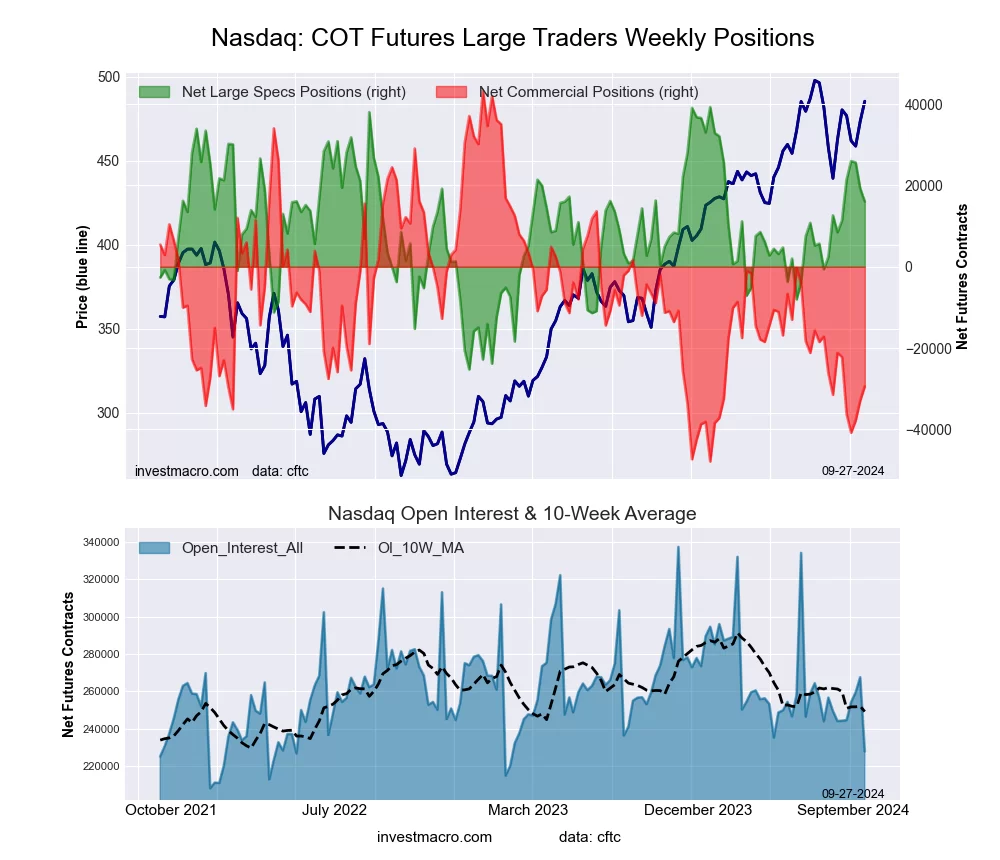 The Nasdaq Mini large speculator standing this week recorded a net position of 16,039 contracts in the data reported through Tuesday. This was a weekly fall of -3,194 contracts from the previous week which had a total of 19,233 net contracts.
The Nasdaq Mini large speculator standing this week recorded a net position of 16,039 contracts in the data reported through Tuesday. This was a weekly fall of -3,194 contracts from the previous week which had a total of 19,233 net contracts.
This week’s current strength score (the trader positioning range over the past three years, measured from 0 to 100) shows the speculators are currently Bullish with a score of 64.0 percent. The commercials are Bearish with a score of 20.2 percent and the small traders (not shown in chart) are Bullish-Extreme with a score of 80.1 percent.
Price Trend-Following Model: Strong Uptrend
Our weekly trend-following model classifies the current market price position as: Strong Uptrend.
| Nasdaq Mini Futures Statistics | SPECULATORS | COMMERCIALS | SMALL TRADERS |
| – Percent of Open Interest Longs: | 23.1 | 58.4 | 17.4 |
| – Percent of Open Interest Shorts: | 16.1 | 71.4 | 11.5 |
| – Net Position: | 16,039 | -29,423 | 13,384 |
| – Gross Longs: | 52,615 | 133,114 | 39,603 |
| – Gross Shorts: | 36,576 | 162,537 | 26,219 |
| – Long to Short Ratio: | 1.4 to 1 | 0.8 to 1 | 1.5 to 1 |
| NET POSITION TREND: | |||
| – Strength Index Score (3 Year Range Pct): | 64.0 | 20.2 | 80.1 |
| – Strength Index Reading (3 Year Range): | Bullish | Bearish | Bullish-Extreme |
| NET POSITION MOVEMENT INDEX: | |||
| – 6-Week Change in Strength Index: | 11.7 | -9.0 | 1.2 |
Russell 2000 Mini Futures:
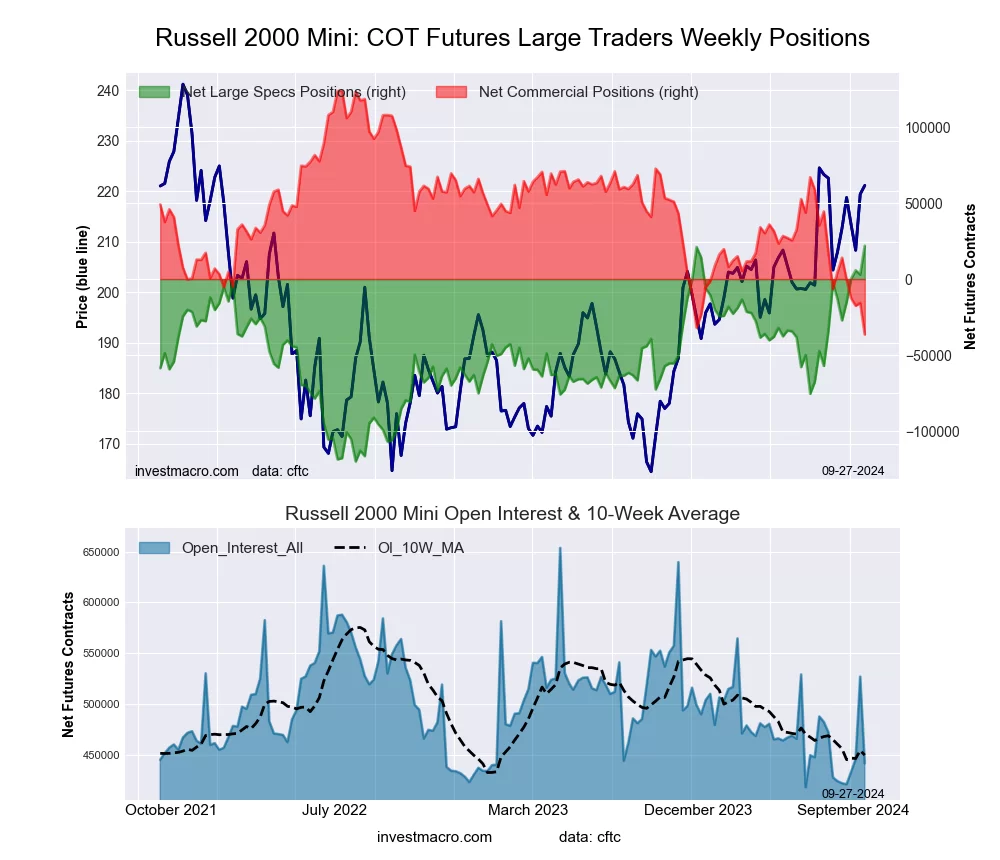 The Russell 2000 Mini large speculator standing this week recorded a net position of 21,907 contracts in the data reported through Tuesday. This was a weekly boost of 18,921 contracts from the previous week which had a total of 2,986 net contracts.
The Russell 2000 Mini large speculator standing this week recorded a net position of 21,907 contracts in the data reported through Tuesday. This was a weekly boost of 18,921 contracts from the previous week which had a total of 2,986 net contracts.
This week’s current strength score (the trader positioning range over the past three years, measured from 0 to 100) shows the speculators are currently Bullish-Extreme with a score of 100.0 percent. The commercials are Bearish-Extreme with a score of 0.0 percent and the small traders (not shown in chart) are Bullish with a score of 78.0 percent.
Price Trend-Following Model: Strong Uptrend
Our weekly trend-following model classifies the current market price position as: Strong Uptrend.
| Russell 2000 Mini Futures Statistics | SPECULATORS | COMMERCIALS | SMALL TRADERS |
| – Percent of Open Interest Longs: | 19.3 | 71.4 | 7.4 |
| – Percent of Open Interest Shorts: | 14.4 | 79.7 | 4.1 |
| – Net Position: | 21,907 | -36,441 | 14,534 |
| – Gross Longs: | 85,342 | 315,752 | 32,545 |
| – Gross Shorts: | 63,435 | 352,193 | 18,011 |
| – Long to Short Ratio: | 1.3 to 1 | 0.9 to 1 | 1.8 to 1 |
| NET POSITION TREND: | |||
| – Strength Index Score (3 Year Range Pct): | 100.0 | 0.0 | 78.0 |
| – Strength Index Reading (3 Year Range): | Bullish-Extreme | Bearish-Extreme | Bullish |
| NET POSITION MOVEMENT INDEX: | |||
| – 6-Week Change in Strength Index: | 24.8 | -25.6 | 19.7 |
Nikkei Stock Average (USD) Futures:
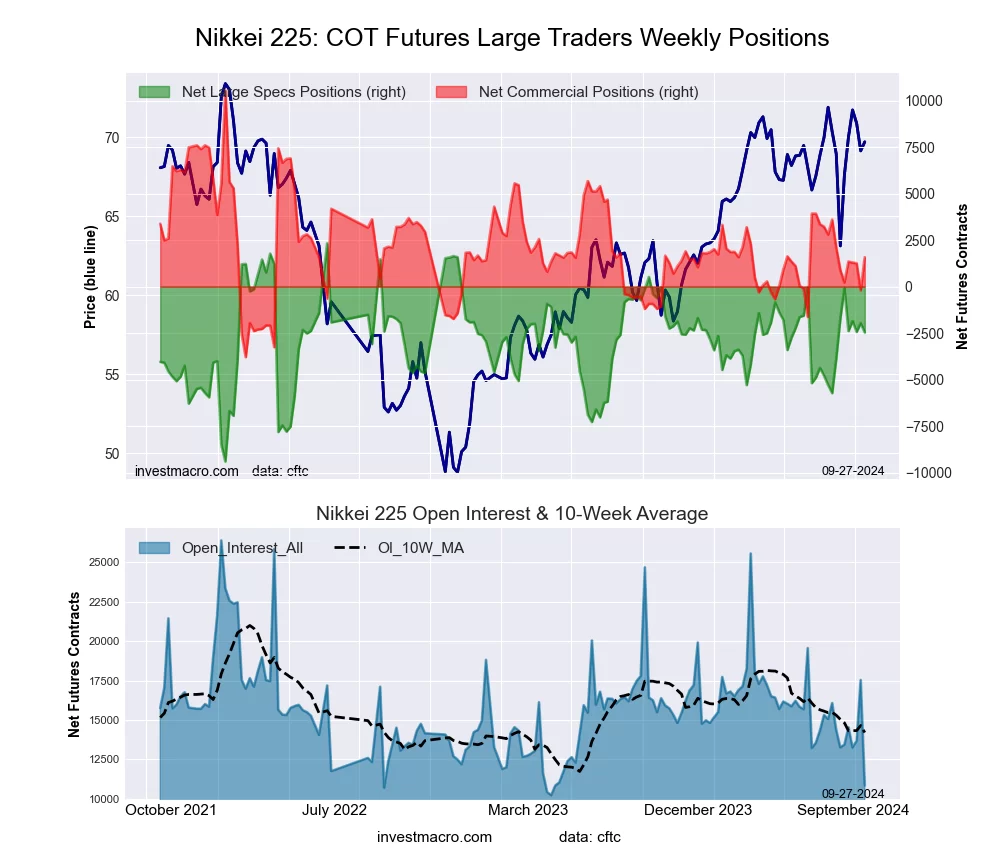 The Nikkei Stock Average (USD) large speculator standing this week recorded a net position of -2,464 contracts in the data reported through Tuesday. This was a weekly decrease of -498 contracts from the previous week which had a total of -1,966 net contracts.
The Nikkei Stock Average (USD) large speculator standing this week recorded a net position of -2,464 contracts in the data reported through Tuesday. This was a weekly decrease of -498 contracts from the previous week which had a total of -1,966 net contracts.
This week’s current strength score (the trader positioning range over the past three years, measured from 0 to 100) shows the speculators are currently Bullish with a score of 59.2 percent. The commercials are Bearish with a score of 37.5 percent and the small traders (not shown in chart) are Bullish with a score of 60.1 percent.
Price Trend-Following Model: Strong Uptrend
Our weekly trend-following model classifies the current market price position as: Strong Uptrend.
| Nikkei Stock Average Futures Statistics | SPECULATORS | COMMERCIALS | SMALL TRADERS |
| – Percent of Open Interest Longs: | 2.0 | 70.2 | 27.7 |
| – Percent of Open Interest Shorts: | 24.7 | 55.7 | 19.5 |
| – Net Position: | -2,464 | 1,576 | 888 |
| – Gross Longs: | 221 | 7,620 | 3,008 |
| – Gross Shorts: | 2,685 | 6,044 | 2,120 |
| – Long to Short Ratio: | 0.1 to 1 | 1.3 to 1 | 1.4 to 1 |
| NET POSITION TREND: | |||
| – Strength Index Score (3 Year Range Pct): | 59.2 | 37.5 | 60.1 |
| – Strength Index Reading (3 Year Range): | Bullish | Bearish | Bullish |
| NET POSITION MOVEMENT INDEX: | |||
| – 6-Week Change in Strength Index: | -6.3 | 4.8 | 1.0 |
MSCI EAFE Mini Futures:
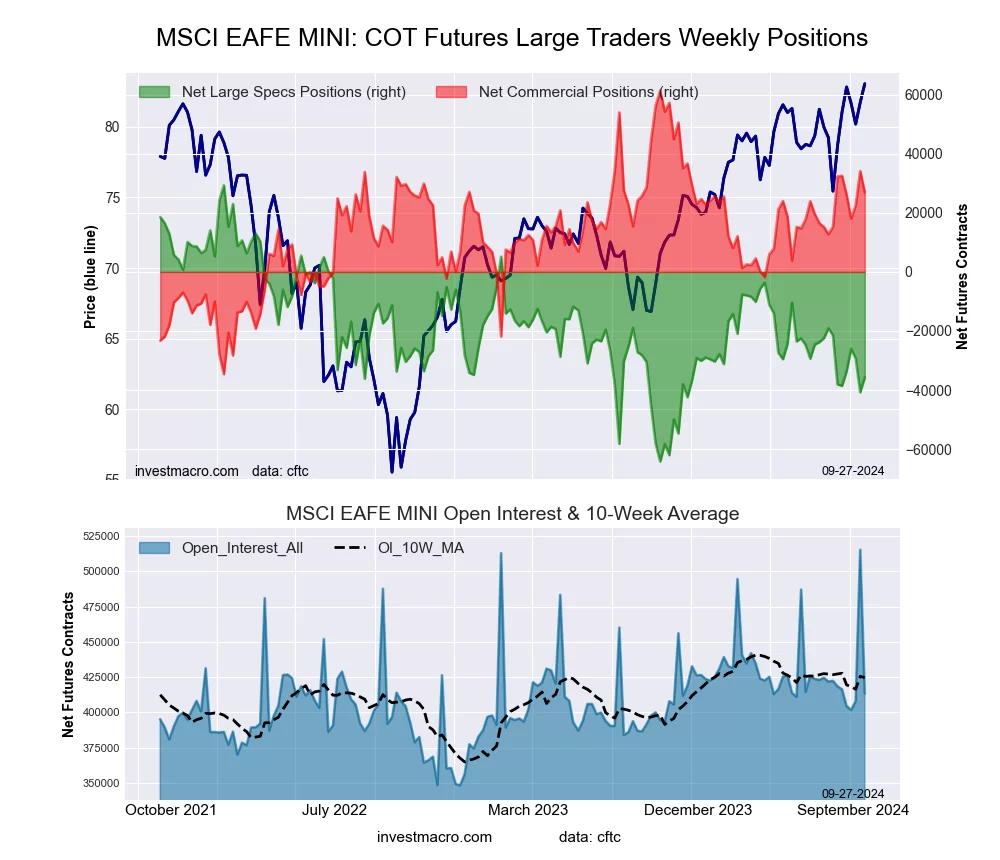 The MSCI EAFE Mini large speculator standing this week recorded a net position of -35,707 contracts in the data reported through Tuesday. This was a weekly increase of 5,043 contracts from the previous week which had a total of -40,750 net contracts.
The MSCI EAFE Mini large speculator standing this week recorded a net position of -35,707 contracts in the data reported through Tuesday. This was a weekly increase of 5,043 contracts from the previous week which had a total of -40,750 net contracts.
This week’s current strength score (the trader positioning range over the past three years, measured from 0 to 100) shows the speculators are currently Bearish with a score of 30.5 percent. The commercials are Bullish with a score of 64.1 percent and the small traders (not shown in chart) are Bullish with a score of 60.6 percent.
Price Trend-Following Model: Strong Uptrend
Our weekly trend-following model classifies the current market price position as: Strong Uptrend.
| MSCI EAFE Mini Futures Statistics | SPECULATORS | COMMERCIALS | SMALL TRADERS |
| – Percent of Open Interest Longs: | 6.7 | 89.8 | 3.3 |
| – Percent of Open Interest Shorts: | 15.4 | 83.2 | 1.2 |
| – Net Position: | -35,707 | 26,947 | 8,760 |
| – Gross Longs: | 27,798 | 371,075 | 13,807 |
| – Gross Shorts: | 63,505 | 344,128 | 5,047 |
| – Long to Short Ratio: | 0.4 to 1 | 1.1 to 1 | 2.7 to 1 |
| NET POSITION TREND: | |||
| – Strength Index Score (3 Year Range Pct): | 30.5 | 64.1 | 60.6 |
| – Strength Index Reading (3 Year Range): | Bearish | Bullish | Bullish |
| NET POSITION MOVEMENT INDEX: | |||
| – 6-Week Change in Strength Index: | 2.6 | -5.6 | 14.7 |
Article By InvestMacro – Receive our weekly COT Newsletter
*COT Report: The COT data, released weekly to the public each Friday, is updated through the most recent Tuesday (data is 3 days old) and shows a quick view of how large speculators or non-commercials (for-profit traders) were positioned in the futures markets.
The CFTC categorizes trader positions according to commercial hedgers (traders who use futures contracts for hedging as part of the business), non-commercials (large traders who speculate to realize trading profits) and nonreportable traders (usually small traders/speculators) as well as their open interest (contracts open in the market at time of reporting). See CFTC criteria here.

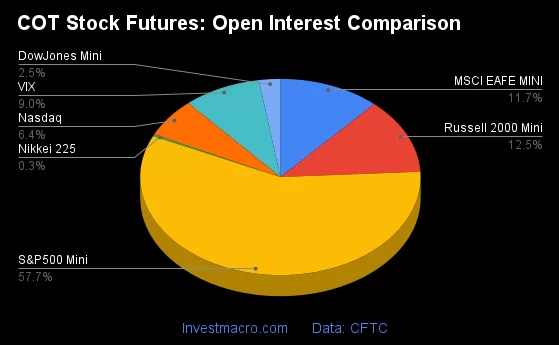
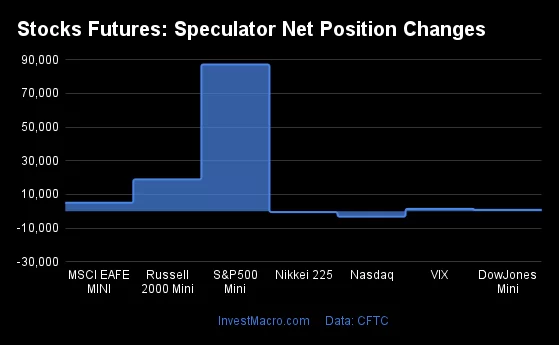
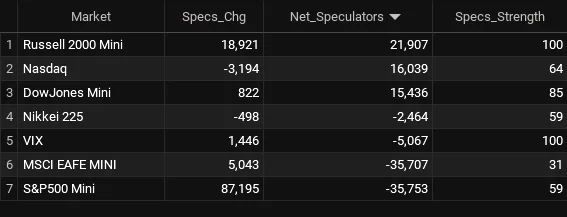
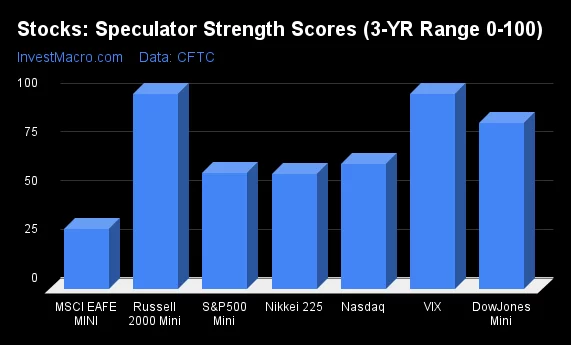
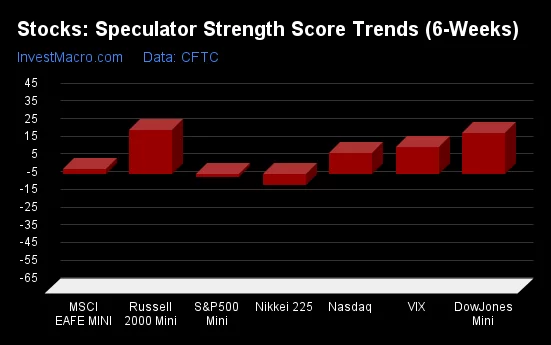

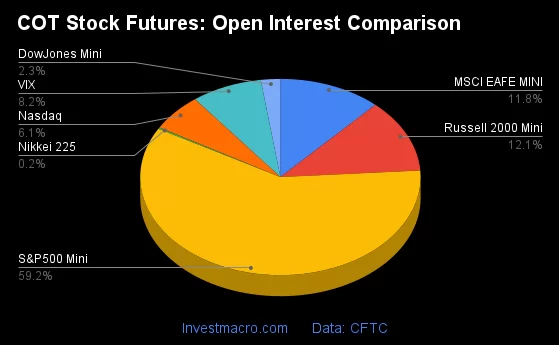

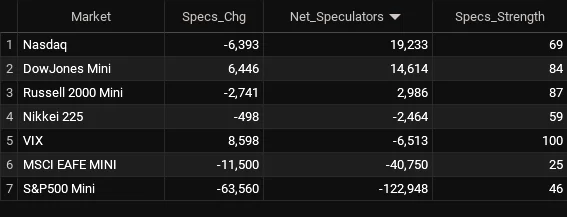
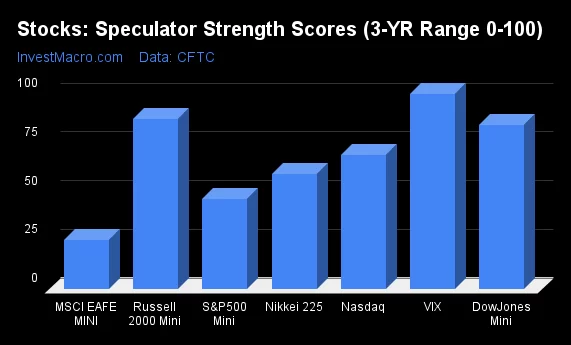
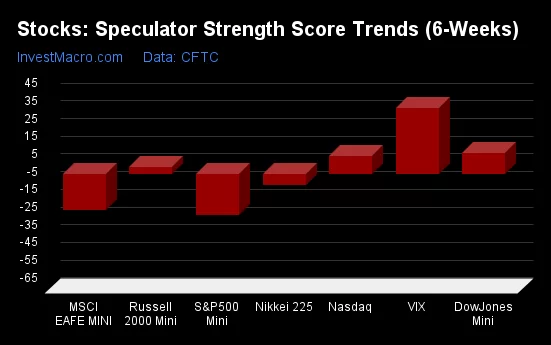
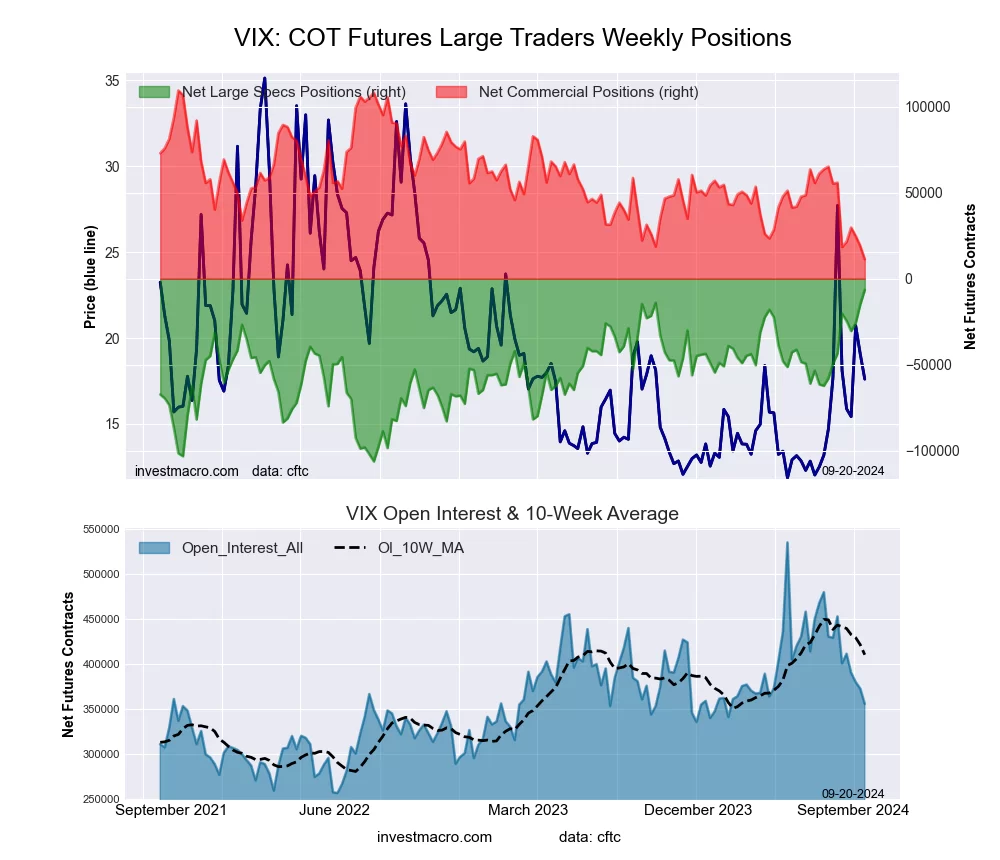

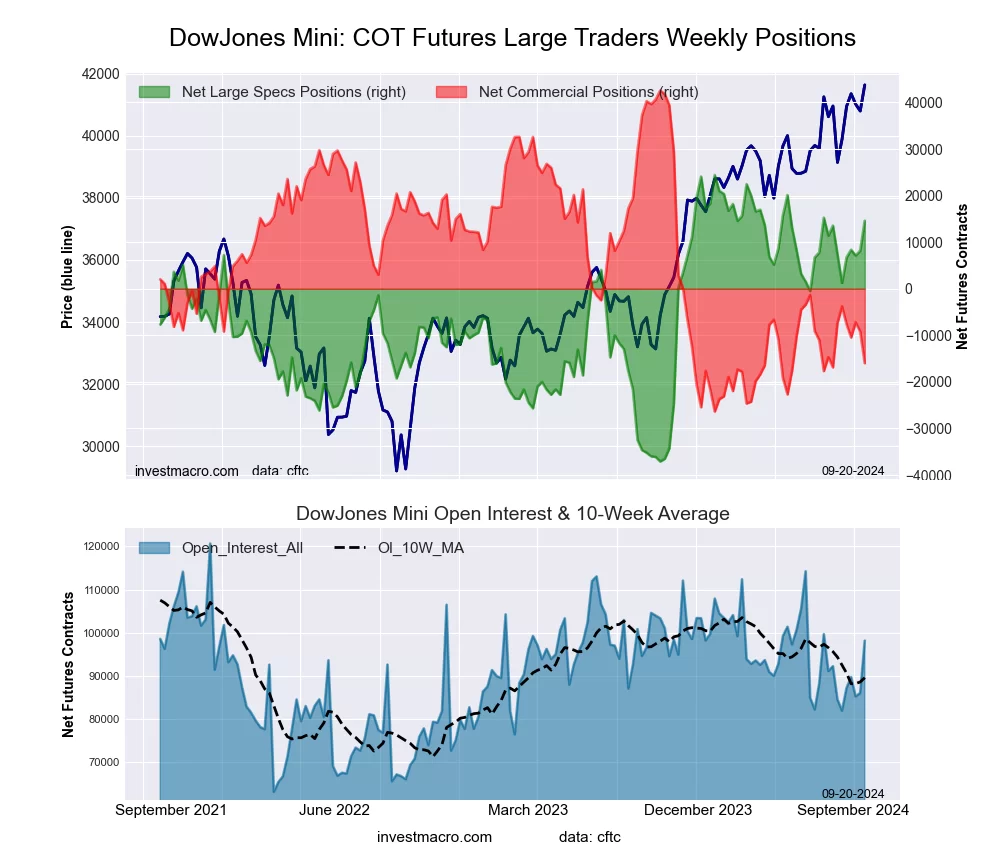
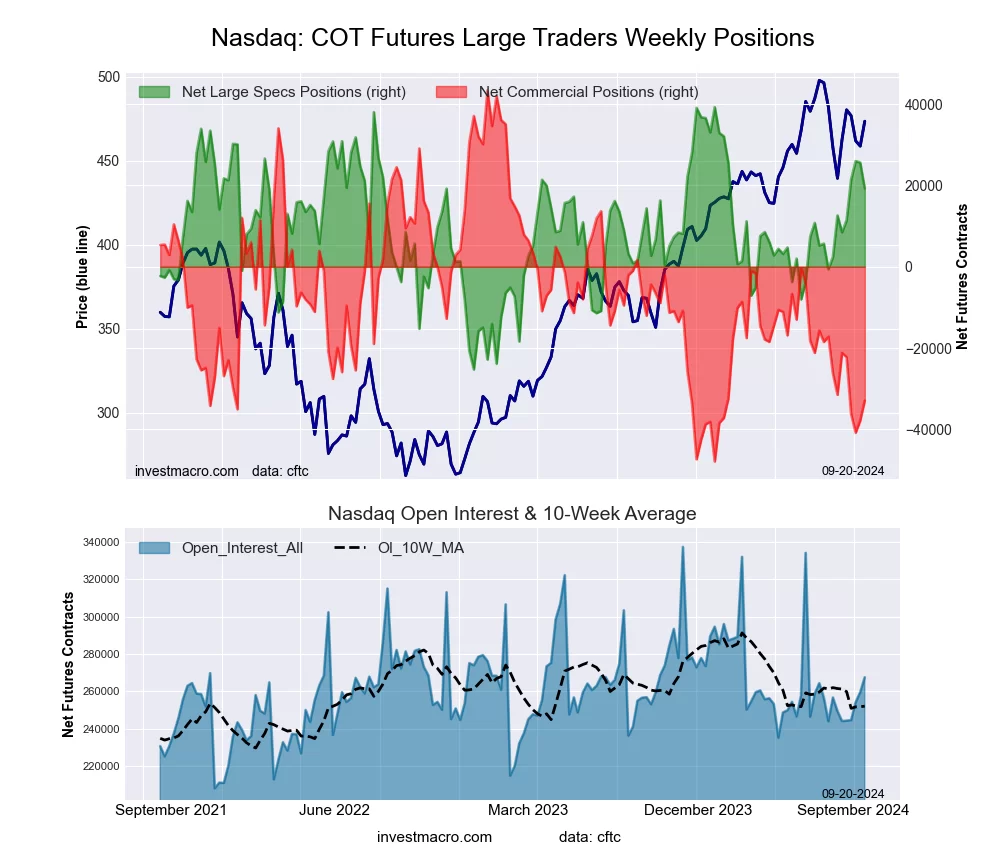
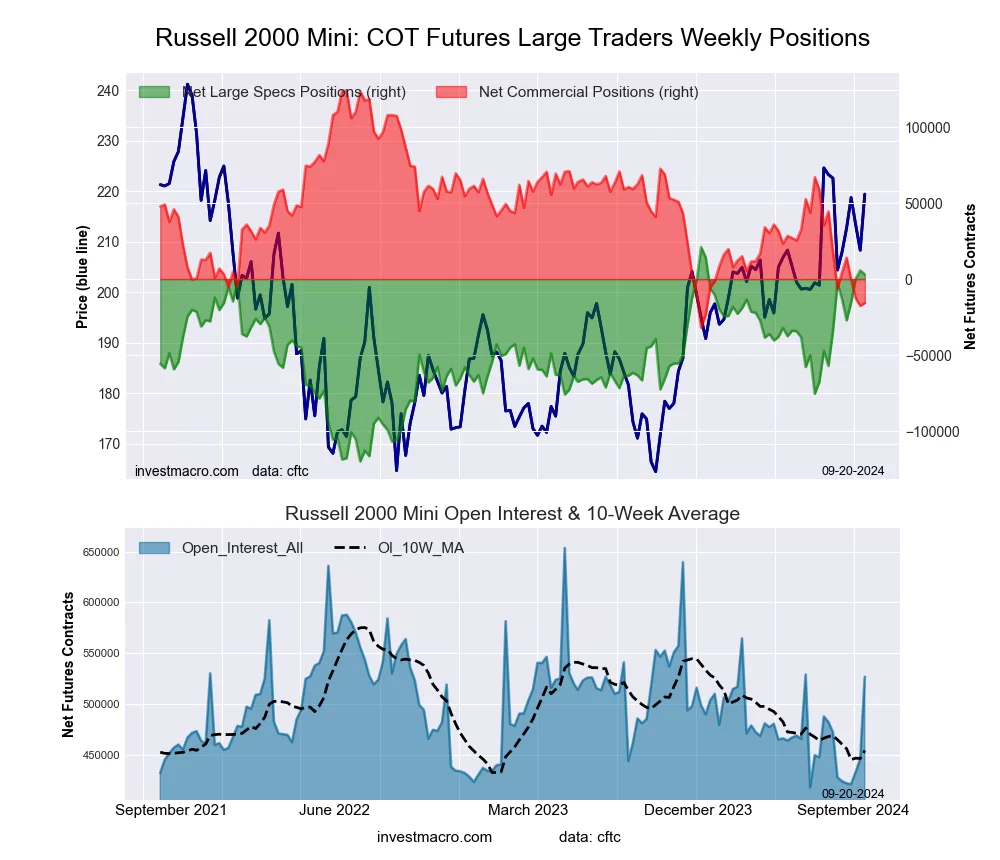
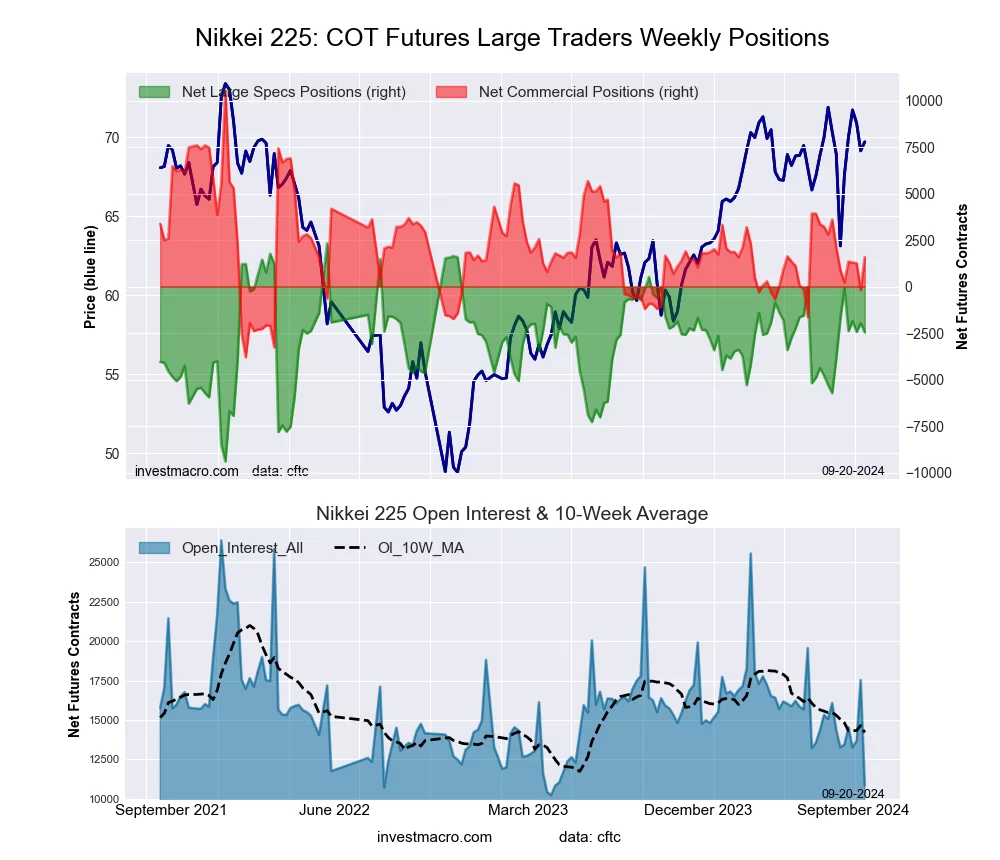
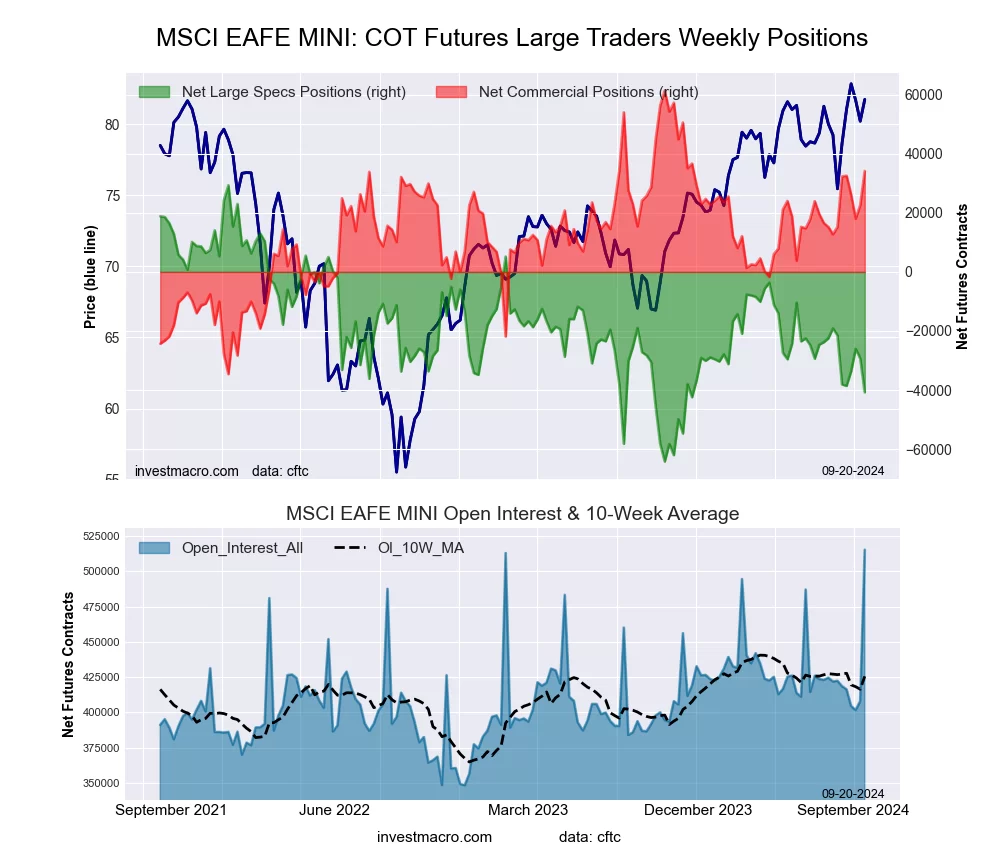



 Article by
Article by 

